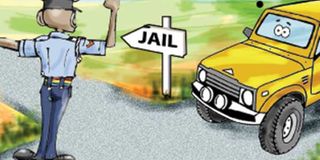Is it a technical grey area, legal anomaly or moral issue?

So if a pedestrian is struck by a bus doing 50kph, because that is within the legal speed permitted in legal terms, the verdict is most likely to be “bad luck”. Now, is that a technical grey area, or a legal anomaly… or a moral issue? ILLUSTRATION | FILE
What you need to know:
- In public places, structures or equipment (parks and playgrounds, staircases, viewing platforms ), where a fall will result in an impact of less than 30kph, regulations are few and if it all goes wrong everyone says “bad luck.”
- So if a pedestrian is struck by a bus doing 50kph, because that is within the legal speed permitted in legal terms, the verdict is most likely to be “bad luck”. Now, is that a technical grey area, or a legal anomaly… or a moral issue?
IF WHILE WALKING down the street you tripped and fell flat on your face, you would hit the pavement at about 15 kph. That could hurt, and even cause superficial injury, but the human body can take most 15 kph impacts with solid objects and will usually emerge almost unharmed.
There is, of course, a difference between a rickety granny and a professional wrestler or rugby player in this respect. The ouch would be significantly bigger if you fell off the top rack of a bunk bed. You would hit the floor at about 25 kph. Whether you awoke in a startled daze or in an ambulance would depend on how you landed, but the injury is more likely to be bruising than breakages, and almost certainly not fatal.
Next, you might fall off a ladder while fixing the gutters on your bungalow. Welcome to the flowerbed … at about 35 kph. If your landing place was a concrete patio, you would almost certainly suffer injury, a high probability of a broken bone or two, but again you would almost certainly survive. For up to about 35 kph, the oops! ouch! and aaargh! are progressively more painful, but the average body basic can usually get up and walk away … perhaps with a limp and some interesting vocabulary.
LETHAL POTENTIAL
However, at higher speed the damage doesn’t just get progressively more severe – it rapidly shifts from fall to … funeral. Fall onto paving slabs from the gutter of a two-storey building, and flesh will meet cement at 50 kph. Breakages move up from possible to almost definite, include a probability of internal ruptures, and you don’t need to be particularly unlucky to kill yourself. These examples and impact figures are the basis of safety regulations, worldwide.
In public places, structures or equipment (parks and playgrounds, staircases, viewing platforms ), where a fall will result in an impact of less than 30kph, regulations are few and if it all goes wrong everyone says “bad luck.”
But where a fall could involve an impact higher than that, design and conduct regulations are strict and mistakes are called “criminal negligence”. A glaring exception to this scientifically based standard is vehicle traffic.
A construction worker hitting the ground at 30kph after a fall, or a pedestrian being hit by the front end of a bus doing 30kph, are much the same thing as far as human muscle, bones and organs are concerned.
So science and logic suggest that in a city street, either pedestrians and vehicles should be physically separated, or the fall (speed) limit should be 30kph. It is more than just interesting then, that the actual speed limit in cities (almost everywhere in the world) is 50kph — official “sanction” for a velocity that is known to be potentially lethal.
So if a pedestrian is struck by a bus doing 50kph, because that is within the legal speed permitted in legal terms, the verdict is most likely to be “bad luck”. Now, is that a technical grey area, or a legal anomaly… or a moral issue?
We may not have an absolute answer to that, but surely it deserves some more questions … next week.





